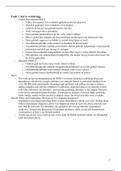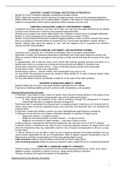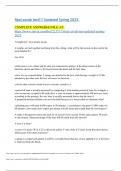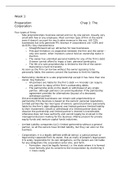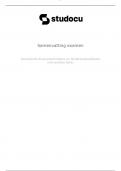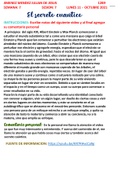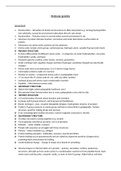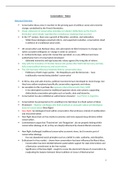Taak 1 wat is verslaving
- Verslaving volgens DSM V
o Vaker en in grotere hoeveelheden gebruiken dan het plan was.
o Mislukte pogingen om te minderen of te stoppen.
o Gebruik en herstel van gebruik kosten veel tijd.
o Sterk verlangen om te gebruiken.
o Door gebruik tekortschieten op het werk, school of thuis.
o Blijven gebruiken ondanks dat het problemen meebrengt in het relationele vlak.
o Door gebruik opgeven van hobby’s, sociale activiteiten of werk.
o Voortdurend gebruik, zelfs wanneer je daardoor in gevaar komt.
o Voortdurend gebruik ondanks weet hebben dat het gebruik lichamelijke of psychische
problemen met zich mee brengt of verergert.
o Grotere hoeveelheden nodig hebben om het effect nog te voelen oftewel tolerantie.
o Het optreden van onthoudingsverschijnselen, die minder hevig worden door meer van
de stof te gebruiken
- Misbruik DSM IV
o Gebruik gaat ten koste van je werk, school of thuis.
o Voortdurend gebruik ondanks terugkerende problemen op sociaal gebied (ruzies).
o Herhaaldelijk gebruik in gevaarlijke situaties zoals in het verkeer.
o Door gebruik kom je herhaaldelijk in contact met politie of justitie
Hasin
- The work group recommendations for DSM-5 revisions included combining abuse and
dependence criteria into a single substance use disorder based on consistent findings from
over 200,000 study participants, dropping legal problems and adding craving as criteria,
adding cannabis and caffeine withdrawal syndromes, aligning tobacco use disorder criteria
with other substance use disorders, and moving gambling disorders to the chapter formerly
reserved for substancerelated disorders. The proposed changes overcome many problems,
while further studies will be needed to address issues for which less data were available.
Should Abuse and Dependence Be Kept as Two Separate Diagnoses?
- Dependence was diagnosed when three or more dependence criteria were met. Among those
with no dependence diagnosis, abuse was diagnosed when at least one abuse criterion was
met. The division into two disorders was guided by the concept that the “dependence
syndrome” formed one dimension of substance problems, while social and interpersonal
consequences of heavy use formed another
- Verslaving als iets wat je hebt en niet wat je bent. In DSM4 misbruik milder als afhankelijk
want niet altijd juist is.
1
, -
- The problems pertaining to the DSM-IV hierarchy of dependence over abuse also included
“diagnostic orphans” , the case of two dependence criteria and no abuse criteria, potentially a
more serious condition than abuse but ineligible for a diagnosis. Also, when the abuse criteria
were analyzed without regard to dependence, their test-retest reliability improved
considerably, suggesting that the hierarchy, not the criteria, led to their poor reliability.
Finally, factor analyses of dependence and abuse criteria (ignoring the DSM-IV hierarchy)
showed that the criteria formed one factor or two highly correlated factors, suggesting that
the criteria should be combined to represent a single disorder
- unidimensionality was found for all DSM-IV criteria for abuse and dependence except legal
problems, indicating that dependence and the remaining abuse criteria all indicate the same
underlying condition. Second, while severity rankings of criteria varied somewhat across
studies, abuse and dependence criteria were always intermixed across the severity spectrum,
similar to the curves shown in Figure 2. Collectively, this large body of evidence supported
removing the distinction between abuse and dependence.
- For DSM-5, combine abuse and dependence criteria into one disorder (Figure 1), with two
additional changes indicated below
Should Any Diagnostic Criteria Be Dropped?
- If any criteria can be removed while retaining diagnostic accuracy, the set will be easier to
use in clinical practice. The work group considered whether two criteria could be dropped:
legal problems and tolerance
- legal problems are not a useful substance use disorder criterion, although such problems may
be an important treatment focus in some settings
- tolerance: most item response theory articles on substance use disorder criteria (Table 2) did
not find anything unique about tolerance relative to the other criteria.
- DECISION: Drop legal problems as a DSM-5 diagnostic criterion.
Should Any Criteria Be Added?
- Craving: Support for craving as a substance use disorder criterion comes indirectly from
behavioral, imaging, pharmacology, and genetics studies. Craving is included in the
dependence criteria in ICD-10, so adding craving to DSM-5 would increase consistency
between the nosologies. the addition of craving to the dependence criteria did not
significantly add information. However, when craving and the three abuse criteria were
added, total information was increased significantly for nicotine, alcohol, cannabis, and
heroin, although not for cocaine use disorders. Clinicians expressed enthusiasm about adding
craving at work group presentations and on the DSM-5 web site
2
- Verslaving volgens DSM V
o Vaker en in grotere hoeveelheden gebruiken dan het plan was.
o Mislukte pogingen om te minderen of te stoppen.
o Gebruik en herstel van gebruik kosten veel tijd.
o Sterk verlangen om te gebruiken.
o Door gebruik tekortschieten op het werk, school of thuis.
o Blijven gebruiken ondanks dat het problemen meebrengt in het relationele vlak.
o Door gebruik opgeven van hobby’s, sociale activiteiten of werk.
o Voortdurend gebruik, zelfs wanneer je daardoor in gevaar komt.
o Voortdurend gebruik ondanks weet hebben dat het gebruik lichamelijke of psychische
problemen met zich mee brengt of verergert.
o Grotere hoeveelheden nodig hebben om het effect nog te voelen oftewel tolerantie.
o Het optreden van onthoudingsverschijnselen, die minder hevig worden door meer van
de stof te gebruiken
- Misbruik DSM IV
o Gebruik gaat ten koste van je werk, school of thuis.
o Voortdurend gebruik ondanks terugkerende problemen op sociaal gebied (ruzies).
o Herhaaldelijk gebruik in gevaarlijke situaties zoals in het verkeer.
o Door gebruik kom je herhaaldelijk in contact met politie of justitie
Hasin
- The work group recommendations for DSM-5 revisions included combining abuse and
dependence criteria into a single substance use disorder based on consistent findings from
over 200,000 study participants, dropping legal problems and adding craving as criteria,
adding cannabis and caffeine withdrawal syndromes, aligning tobacco use disorder criteria
with other substance use disorders, and moving gambling disorders to the chapter formerly
reserved for substancerelated disorders. The proposed changes overcome many problems,
while further studies will be needed to address issues for which less data were available.
Should Abuse and Dependence Be Kept as Two Separate Diagnoses?
- Dependence was diagnosed when three or more dependence criteria were met. Among those
with no dependence diagnosis, abuse was diagnosed when at least one abuse criterion was
met. The division into two disorders was guided by the concept that the “dependence
syndrome” formed one dimension of substance problems, while social and interpersonal
consequences of heavy use formed another
- Verslaving als iets wat je hebt en niet wat je bent. In DSM4 misbruik milder als afhankelijk
want niet altijd juist is.
1
, -
- The problems pertaining to the DSM-IV hierarchy of dependence over abuse also included
“diagnostic orphans” , the case of two dependence criteria and no abuse criteria, potentially a
more serious condition than abuse but ineligible for a diagnosis. Also, when the abuse criteria
were analyzed without regard to dependence, their test-retest reliability improved
considerably, suggesting that the hierarchy, not the criteria, led to their poor reliability.
Finally, factor analyses of dependence and abuse criteria (ignoring the DSM-IV hierarchy)
showed that the criteria formed one factor or two highly correlated factors, suggesting that
the criteria should be combined to represent a single disorder
- unidimensionality was found for all DSM-IV criteria for abuse and dependence except legal
problems, indicating that dependence and the remaining abuse criteria all indicate the same
underlying condition. Second, while severity rankings of criteria varied somewhat across
studies, abuse and dependence criteria were always intermixed across the severity spectrum,
similar to the curves shown in Figure 2. Collectively, this large body of evidence supported
removing the distinction between abuse and dependence.
- For DSM-5, combine abuse and dependence criteria into one disorder (Figure 1), with two
additional changes indicated below
Should Any Diagnostic Criteria Be Dropped?
- If any criteria can be removed while retaining diagnostic accuracy, the set will be easier to
use in clinical practice. The work group considered whether two criteria could be dropped:
legal problems and tolerance
- legal problems are not a useful substance use disorder criterion, although such problems may
be an important treatment focus in some settings
- tolerance: most item response theory articles on substance use disorder criteria (Table 2) did
not find anything unique about tolerance relative to the other criteria.
- DECISION: Drop legal problems as a DSM-5 diagnostic criterion.
Should Any Criteria Be Added?
- Craving: Support for craving as a substance use disorder criterion comes indirectly from
behavioral, imaging, pharmacology, and genetics studies. Craving is included in the
dependence criteria in ICD-10, so adding craving to DSM-5 would increase consistency
between the nosologies. the addition of craving to the dependence criteria did not
significantly add information. However, when craving and the three abuse criteria were
added, total information was increased significantly for nicotine, alcohol, cannabis, and
heroin, although not for cocaine use disorders. Clinicians expressed enthusiasm about adding
craving at work group presentations and on the DSM-5 web site
2

